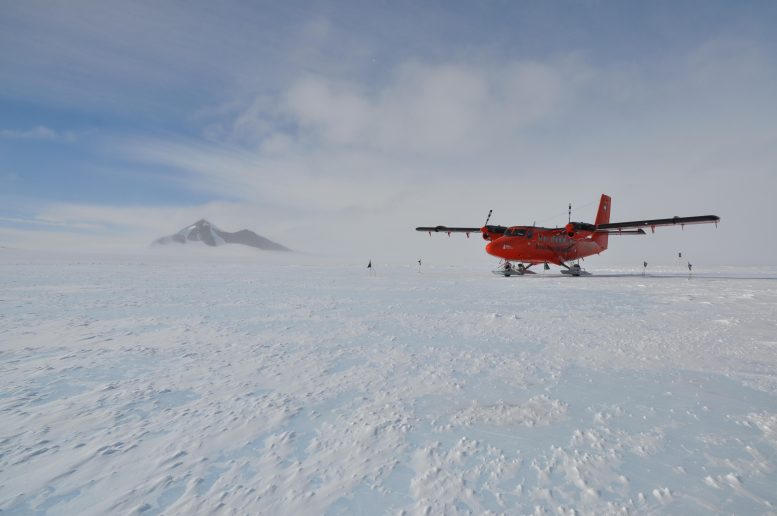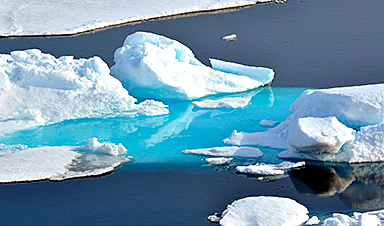According to scientists, the Amundsen Sea Embayment, which is the fastest-changing region in Antarctica, has experienced a loss of more than 3,000 billion tons of ice in 25 years. If all this ice were to be stacked, it would tower over 2 km tall, which is equivalent to 7.4 times the height of the Shard in London. Alternatively, if it were to cover Manhattan, it would stand at a staggering 61 km, or the equivalent of 137 Empire State Buildings stacked on top of each other.
The Amundsen Sea Embayment in West Antarctica is home to 20 major glaciers that cover an area more than four times the size of the UK. These glaciers play a crucial role in determining the level of the world’s oceans as they hold vast amounts of water in snow and ice. If all of this were to drain into the sea, it could cause global sea levels to rise by over one meter.
The research, led by Dr. Benjamin Davison at the University of Leeds, calculated the “mass balance” of the Amundsen Sea Embayment. This describes the balance between the mass of snow and ice gain due to snowfall and mass lost through calving, where icebergs form at the end of a glacier and drift out to sea.

Plane landing in the Amundsen Sea Embayment. Credit: University of Leeds
Dr. Davison, a Research Fellow at the Institute for Climate and Atmospheric Science at Leeds, said: “The 20 glaciers in West Antarctica have lost an awful lot of ice over the last quarter of a century and there is no sign that the process is going to reverse anytime soon although there were periods where the rate of mass loss did ease slightly.
“Scientists are monitoring what is happening in the Amundsen Sea Embayment because of the crucial role it plays in sea-level rise. If ocean levels were to rise significantly in future years, there are communities around the world who would experience extreme flooding.”
The research has been published in the scientific journal Nature Communications.
Importance of extreme snowfall events
Using climate models that show how air currents move around the world, the scientists identified that the Amundsen Sea Embayment had experienced several extreme snowfall events over the 25-year study period.
These would have resulted in periods of heavy snowfall and periods of very little snowfall or a “snow drought”.
The researchers factored these extreme events into their calculations. Surprisingly, they found that these events contributed up to half of the ice change at certain times, and therefore played a key role in the contribution the Amundsen Sea Embayment was making to sea level rise during certain time periods.

Research base in the Amundsen Sea Embayment. Credit: University of Leeds
In contrast, during the winters of 2019 and 2020, there was very heavy snowfall. The scientists estimated that this heavy snowfall mitigated the sea level contribution from the Amundsen Sea Embayment, reducing it to about half of what it would have been in an average year.
Dr. Davison said: “Changes in ocean temperature and circulation appear to be driving the long-term, large-scale changes in West Antarctica ice sheet mass. We absolutely need to research those more because they are likely to control the overall sea level contribution from West Antarctica.
“However, we were really surprised to see just how much periods of extremely low or high snowfall could affect the ice sheet over two to five-year periods – so much so that we think they could play an important, albeit secondary role, in controlling rates of West Antarctic ice loss.”
Dr. Pierre Dutrieux, a scientist at the British Antarctic Survey and co-author of the study, added: “Ocean temperature changes and glacial dynamics appear strongly connected in this part of the world, but this work highlights the large variability and unexpected processes by which snowfall also plays a direct role in modulating glacier mass. “

Amundsen Sea Embayment. Credit: University of Leeds
New glacier named
The ice loss from the region over the past 25 years has seen the retreat of the Pine Island Glacier, also known as PIG.
As it retreated, one of its tributary glaciers became detached from the main glacier and rapidly accelerated. As a result, the tributary glacier has now been named by the UK Antarctic Place-names Committee, Piglet Glacier, so that it can be unambiguously located and identified by future studies.
Dr. Anna Hogg, one of the authors of the paper and Associate Professor at the Institute of Climate and Atmospheric Science at Leeds, said: “As well as shedding new light on the role of extreme snowfall variability on ice sheet mass changes, this research also provides new estimates of how quickly this important region of Antarctica is contributing to sea level rise.
“Satellite observations have shown that the newly named Piglet Glacier accelerated its ice speed by 40%, as the larger PIG retreated to its smallest extent since records began.”
Satellites such as the European Space Agency’s Copernicus Sentinel-1 satellite, which uses sensors that ‘see’ through cloud even during the long Polar night, have transformed the ability of scientists to monitor remote regions and to monitor the incredibly rapid change taking place in Antarctica.
News
Johns Hopkins Researchers Uncover a New Way To Kill Cancer Cells
A new study reveals that blocking ribosomal RNA production rewires cancer cell behavior and could help treat genetically unstable tumors. Researchers at the Johns Hopkins Kimmel Cancer Center and the Department of Radiation Oncology and Molecular [...]
AI matches doctors in mapping lung tumors for radiation therapy
In radiation therapy, precision can save lives. Oncologists must carefully map the size and location of a tumor before delivering high-dose radiation to destroy cancer cells while sparing healthy tissue. But this process, called [...]
Scientists Finally “See” Key Protein That Controls Inflammation
Researchers used advanced microscopy to uncover important protein structures. For the first time, two important protein structures in the human body are being visualized, thanks in part to cutting-edge technology at the University of [...]
AI tool detects 9 types of dementia from a single brain scan
Mayo Clinic researchers have developed a new artificial intelligence (AI) tool that helps clinicians identify brain activity patterns linked to nine types of dementia, including Alzheimer's disease, using a single, widely available scan—a transformative [...]
Is plastic packaging putting more than just food on your plate?
New research reveals that common food packaging and utensils can shed microscopic plastics into our food, prompting urgent calls for stricter testing and updated regulations to protect public health. Beyond microplastics: The analysis intentionally [...]
Aging Spreads Through the Bloodstream
Summary: New research reveals that aging isn’t just a local cellular process—it can spread throughout the body via the bloodstream. A redox-sensitive protein called ReHMGB1, secreted by senescent cells, was found to trigger aging features [...]
AI and nanomedicine find rare biomarkers for prostrate cancer and atherosclerosis
Imagine a stadium packed with 75,000 fans, all wearing green and white jerseys—except one person in a solid green shirt. Finding that person would be tough. That's how hard it is for scientists to [...]
Are Pesticides Breeding the Next Pandemic? Experts Warn of Fungal Superbugs
Fungicides used in agriculture have been linked to an increase in resistance to antifungal drugs in both humans and animals. Fungal infections are on the rise, and two UC Davis infectious disease experts, Dr. George Thompson [...]
Scientists Crack the 500-Million-Year-Old Code That Controls Your Immune System
A collaborative team from Penn Medicine and Penn Engineering has uncovered the mathematical principles behind a 500-million-year-old protein network that determines whether foreign materials are recognized as friend or foe. How does your body [...]
Team discovers how tiny parts of cells stay organized, new insights for blocking cancer growth
A team of international researchers led by scientists at City of Hope provides the most thorough account yet of an elusive target for cancer treatment. Published in Science Advances, the study suggests a complex signaling [...]
Nanomaterials in Ophthalmology: A Review
Eye diseases are becoming more common. In 2020, over 250 million people had mild vision problems, and 295 million experienced moderate to severe ocular conditions. In response, researchers are turning to nanotechnology and nanomaterials—tools that are transforming [...]
Natural Plant Extract Removes up to 90% of Microplastics From Water
Researchers found that natural polymers derived from okra and fenugreek are highly effective at removing microplastics from water. The same sticky substances that make okra slimy and give fenugreek its gel-like texture could help [...]
Instant coffee may damage your eyes, genetic study finds
A new genetic study shows that just one extra cup of instant coffee a day could significantly increase your risk of developing dry AMD, shedding fresh light on how our daily beverage choices may [...]
Nanoneedle patch offers painless alternative to traditional cancer biopsies
A patch containing tens of millions of microscopic nanoneedles could soon replace traditional biopsies, scientists have found. The patch offers a painless and less invasive alternative for millions of patients worldwide who undergo biopsies [...]
Small antibodies provide broad protection against SARS coronaviruses
Scientists have discovered a unique class of small antibodies that are strongly protective against a wide range of SARS coronaviruses, including SARS-CoV-1 and numerous early and recent SARS-CoV-2 variants. The unique antibodies target an [...]
Controlling This One Molecule Could Halt Alzheimer’s in Its Tracks
New research identifies the immune molecule STING as a driver of brain damage in Alzheimer’s. A new approach to Alzheimer’s disease has led to an exciting discovery that could help stop the devastating cognitive decline [...]





















